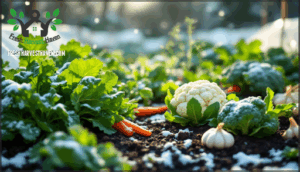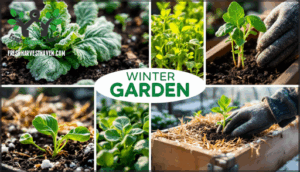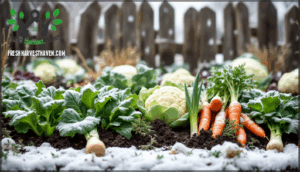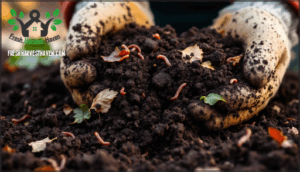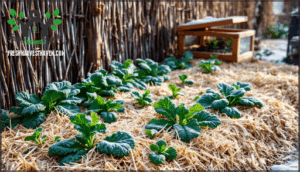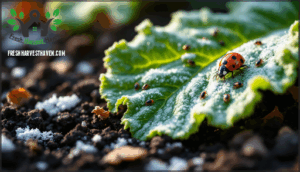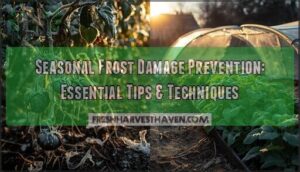This site is supported by our readers. We may earn a commission, at no cost to you, if you purchase through links.
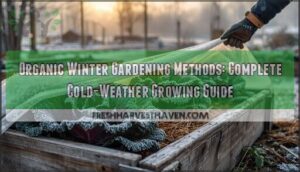 Most gardeners assume their beds go dormant once frost arrives, but winter can be one of the most productive seasons if you understand how plants respond to cold stress. Certain crops actually improve in flavor after exposure to freezing temperatures—kale synthesizes more sugars as a natural antifreeze, while parsnips convert starches to sweetness below 32°F.
Most gardeners assume their beds go dormant once frost arrives, but winter can be one of the most productive seasons if you understand how plants respond to cold stress. Certain crops actually improve in flavor after exposure to freezing temperatures—kale synthesizes more sugars as a natural antifreeze, while parsnips convert starches to sweetness below 32°F.
Organic winter gardening methods utilize these cold-adapted physiological processes rather than fighting against them. By selecting frost-tolerant varieties, insulating soil with organic matter, and using physical barriers strategically, you’ll maintain harvests through months when most gardens sit barren.
The key lies in working with seasonal rhythms instead of attempting to replicate summer conditions.
Table Of Contents
- Key Takeaways
- Benefits of Organic Winter Gardening
- Choosing Winter-Hardy Organic Crops
- Preparing Soil for Organic Winter Gardens
- Protecting Winter Gardens Organically
- Managing Winter Pests and Diseases Organically
- Frequently Asked Questions (FAQs)
- What is the 3 year rule in gardening?
- What do you plant in your garden in the winter time?
- What month do you start a winter garden?
- What do I do with my vegetable garden at the end of the season?
- How do I winterize greenhouse structures properly?
- When should I harvest winter vegetables optimally?
- Can I grow herbs indoors during winter?
- What lighting helps winter seed starting indoors?
- How do I prevent winter watering mistakes?
- How do I water winter garden plants?
- Conclusion
Key Takeaways
- Winter crops like kale and parsnips convert starches to sugars when exposed to freezing temperatures, creating sweeter flavors and natural antifreeze compounds that improve both taste and cold tolerance by 20–30%.
- Organic winter gardening builds soil health through cover crops and reduced pest pressure from cold temperatures, eliminating the need for synthetic fertilizers and pesticides while strengthening mycorrhizal networks and nutrient cycling year-round.
- Strategic use of season extension tools like row covers, cold frames, and proper mulching (3–4 inches applied after ground begins freezing) allows continuous harvests of frost-tolerant crops that survive temperatures as low as 0°F.
- Selecting crops based on cold hardiness and photoperiod tolerance—such as brassicas, root vegetables, and leafy greens that thrive in 10–12 hours of daylight—transforms dormant months into productive growing seasons without artificial heat.
Benefits of Organic Winter Gardening
Winter gardening doesn’t mean pausing your organic practices until spring rolls around. You can maintain productive beds through cold months while strengthening your soil ecosystem and cutting back on interventions.
Here’s what makes organic winter gardening worth the effort.
Extending The Harvest Season
When the first frost threatens to end your growing season, you don’t have to pack away your tools and resign yourself to months of store-bought produce. Cold frames, row covers, and succession planting allow you to extend the growing season well into winter.
These cold weather gardening techniques and season extension methods transform your fall garden shift into continuous harvest opportunities, whether you’re exploring greenhouse growing or simple indoor growing setups.
Improving Soil Health and Biodiversity
While season extension tools put fresh produce on your table, the real magic happens beneath the surface where winter gardening builds soil structure and invites beneficial organisms to thrive. Winter cover crops and green manure options enrich your soil during dormant months, while vermicomposting methods and compost tea benefits accelerate nutrient cycling year-round.
Winter gardening’s true value lies underground, where cover crops and beneficial organisms quietly build soil structure and accelerate nutrient cycling year-round
The mycorrhizal fungi role in establishing symbiotic relationships with plant roots strengthens soil fertility, even when soil temperature drops.
Your crop rotation planning across seasons creates ecological systems that naturally suppress pathogens and build organic matter, reducing dependence on external inputs while establishing resilient soil ecosystems.
Reducing Chemical Inputs Year-Round
By eliminating synthetic fertilizers and pesticides from your winter garden, you’re not just protecting your plants—you’re building a chemical-free food system that pays dividends season after season. Winter gardening naturally reduces your reliance on synthetic chemicals because cooler temperatures suppress many pest populations, lessening pressure for interventions.
Instead, you’ll rely on organic gardening principles like crop rotation, companion planting, and soil testing to maintain fertility. Natural fertilizers such as compost and cover crops replenish soil nutrients without pesticide residues, while water conservation strategies during dormant months further minimize inputs.
This systematic approach strengthens soil fertility organically, creating self-sustaining garden ecosystems year-round.
Choosing Winter-Hardy Organic Crops
Your winter garden doesn’t need to hibernate, and choosing the right crops makes all the difference. Not every vegetable can endure frost and shortened days, but certain varieties thrive when temperatures drop.
We’ll walk you through the crops that’ll actually produce through the cold months, organized by their cold tolerance, light requirements, and growing potential.
Frost-Tolerant Vegetable Varieties
Certain vegetables outperform others when temperatures drop. Cold-hardy greens like kale, collards, and spinach varieties such as Winter Bloomsdale withstand freezing down to 0°F. Root crop resilience means carrots and beets survive to 15°F with minimal quality loss. Brassica frost tolerance shines with broccoli and cauliflower enduring 15–28°F ranges. Garlic hardiness extends through 10°F without yield loss.
These hardy crops develop antifreeze proteins and accumulate sugars, increasing frost tolerance by 20–30%. This makes them ideal for your cold weather gardening.
Gradual temperature decline over two weeks boosts frost hardiness by 35%, so plan your growing methods accordingly. Consider using row covers to extend the growing season.
Selecting Crops for Shorter Daylight
As you move into winter gardening, daylight hours shrink dramatically, and your crop choices must adapt to this fundamental shift in growing conditions. Photoperiod-sensitive crops like leafy greens, brassicas, and root vegetables tolerate reduced light better than fruiting plants. Low-light varieties perform well with 10–12 hours of daylight.
Winter crop rotation and succession planting extend harvests across months. For organic gardening in short days, consider indoor seed starting to boost seedling vigor before transplanting hardy crops outdoors.
Best Edible Plants for Cold Weather
You’ll find that cold weather gardening demands crops engineered by nature for frost survival. Leafy greens like kale and spinach lead your winter gardening lineup, surviving temperatures down to 0°F while maintaining yields.
Your organic gardening success hinges on selecting vegetables from proven cold-hardy categories:
- Brassica family crops including cabbage and cauliflower tolerate 10°F when established
- Root vegetables such as parsnips and carrots improve flavor after frost exposure
- Allium crops like leeks and green onions withstand heavy freezes without protection
Winter herbs including thyme and sage offer perennial harvests across multiple seasons. Collard greens offer better freeze resistance compared to kale.
Preparing Soil for Organic Winter Gardens
Healthy winter soil starts with preparation before the ground freezes. You’ll need to enrich depleted beds, protect soil structure, and build fertility for spring crops.
Here’s how to prepare your organic garden soil for cold-weather growing.
Adding Compost and Organic Matter
Incorporating compost and organic matter into your winter garden soil functions much like adding a thermal battery that releases nutrients slowly while buffering temperature extremes.
You’ll want to apply well-aged compost at a rate of two to three inches across planting beds, prioritizing nutrient-dense materials like worm composting castings for immediate nutrient cycling.
Mix in organic matter at least four to six weeks before planting to allow adequate decomposition rates, which guarantees your soil amendments integrate properly without competing for nitrogen during establishment.
Using Cover Crops for Winter Soil Health
Planting winter-hardy cover crops before the first freeze works like setting a foundation that protects soil all season. You’ll achieve approximately 40% erosion reduction when using overwintering species such as winter cereal rye, which establishes dense root networks that stabilize topsoil.
These crops boost nutrient cycling by storing nitrogen during dormancy and releasing it through spring decomposition, improving organic matter content and biodiversity for your cool season crop selection while supporting sustainable agriculture goals.
Preventing Soil Compaction and Erosion
Winter rain and foot traffic can destroy months of soil-building work, so you’ll need strategic methods to preserve structure and prevent valuable topsoil loss during wet, freezing conditions.
Apply organic soil amendments like compost between terraced garden beds to improve water quality and reduce environmental impact.
Use reduced tillage methods combined with winter cover crops along contour winter planting lines to maintain soil analysis indicators.
These organic gardening principles support sustainable agriculture through measurable protection.
Protecting Winter Gardens Organically
Protecting your winter garden organically means shielding plants from harsh conditions while maintaining ecological balance. You’ll need to insulate vulnerable roots, moderate temperature fluctuations, and create physical barriers against freezing winds.
The following techniques provide layered defense systems that work with natural processes rather than against them.
Organic Mulching Techniques
Mulch acts as your winter garden’s insulating blanket, moderating soil temperature fluctuations while suppressing weeds and retaining moisture throughout the dormant season. Apply organic materials like straw, shredded leaves, or compost at depths of three to four inches once the ground begins freezing.
Proper timing matters—mulching too early can delay soil cooling and attract pests, while late application won’t adequately protect roots. These organic farming methods align with soil health principles while supporting winter vegetable gardening through natural weed suppression and moisture retention.
Insulating Roots and Plant Crowns
Once mulch shields the soil surface, you’ll need to target the plant’s most vulnerable zones—the roots and crowns where freeze-thaw cycles can heave plants from the ground or cause fatal tissue damage. Pile additional mulch materials around plant crowns to maintain insulation, particularly for root crops like carrots and beets.
In zones with reliable snow cover, the natural blanket provides excellent frost protection—leaving plants undisturbed under snow prevents rapid temperature swings better than most artificial covers.
Using Row Covers and Frost Blankets
When mulch and snow aren’t enough—or when you’re dealing with crops in exposed beds or unseasonably harsh cold snaps—you can add a breathable shield above your plants with row covers and frost blankets. These fabric row covers trap radiant heat while allowing light transmission for photosynthesis, extending the growing season by regulating temperature around vulnerable plants.
Install covers using the following methods:
- Drape spun-bonded polyester directly over crops for quick frost protection and pest exclusion
- Secure edges with soil, stakes, or sandbags to prevent wind displacement while maintaining airflow
- Use hoops or cold frame structures for heavier-weight blankets that need clearance above foliage
- Remove covers during mild periods to prevent excessive heat buildup and moisture condensation
Managing Winter Pests and Diseases Organically
Even in winter’s quiet months, pests and diseases can threaten your organic garden if left unchecked. You’ll need to monitor for cold-weather insects, fungal issues, and overwintering pests that emerge during mild spells.
The following strategies will help you protect your crops without synthetic chemicals while maintaining the health of your winter garden ecosystem.
Identifying Common Winter Garden Pests
Despite winter’s chill, several pests remain active in your vegetable garden, and early detection protects organic gardening principles from compromise. Aphids overwinter as eggs or adults in plant debris, with winter crop incidence ranging from 1% to 3%. Colorado potato beetles burrow 5 to 10 inches underground, emerging in spring. Slug activity persists when soil temperatures exceed 38°F, particularly gray field slugs near field margins.
Scale insects and mealybugs hide in bark crevices, while rodent shelters form in mulch and debris, threatening your vegetables throughout cold months.
Natural Pest Control Methods
After identifying winter pests, you’ll need effective organic farming methods that align with organic gardening principles. Companion planting deters aphids when you position alliums near susceptible organic vegetables. Beneficial insects like lacewings consume pest eggs, reducing populations by 40% to 60%.
Natural sprays from neem or garlic target overwintering scales without synthetic pesticides. Crop rotation prevents beetle resurgence by disrupting life cycles.
Winter weeding eliminates pest refuges, supporting agricultural practices that preserve soil health while controlling infestations organically.
Maintaining Garden Sanitation and Hygiene
Your garden’s cleanliness directly determines whether pests find shelter or starve through winter, making sanitation a non-negotiable practice in organic systems. Remove diseased plant debris weekly to prevent pathogen control failures that compromise food safety. Sterilize pruners between cuts using diluted vinegar, following proper tool sanitation protocols.
Composting practices require hot temperatures—140°F to 160°F—to eliminate pathogens before enriching your soil. You’ll protect water purity by preventing runoff from decomposing materials, and proper waste disposal keeps organic gardening principles intact throughout winter.
Frequently Asked Questions (FAQs)
What is the 3 year rule in gardening?
The three-year rule in gardening refers to crop rotation, where you avoid planting the same family of crops in the same bed for at least three years.
This practice breaks pest cycles, reduces disease buildup, and maintains soil fertility through balanced nutrient use.
What do you plant in your garden in the winter time?
Gardeners supposedly "hibernate" when snow arrives, but you can grow leafy greens like kale, spinach, and arugula alongside cold-season varieties such as carrots and Brussels sprouts—nutrient-dense vegetables that thrive in frost and shorter daylight.
What month do you start a winter garden?
Start seed starting indoors about 6-8 weeks before your first frost date, usually in late summer.
Regional climate dictates your planting time, but fall planting strategies for winter vegetable gardening generally begin between July and September across most zones.
What do I do with my vegetable garden at the end of the season?
End-of-season garden cleanup shapes next year’s success. Remove spent plants and harvest any remaining fall crops, then enrich your garden beds with compost to restore nutrients.
Clean tools thoroughly and sketch out planting time strategies for spring while soil preparation lessons are fresh.
How do I winterize greenhouse structures properly?
Winterizing your greenhouse isn’t rocket science, but skipping it invites structural collapse and frozen crops.
Clean debris, inspect for cracks, add insulation, and check heating systems. Guarantee proper ventilation strategies and clear snow promptly to maintain structural integrity and your winter vegetable gardening microclimate.
When should I harvest winter vegetables optimally?
Harvest winter vegetables when they reach full size but before hard freezes damage cell structure.
Most cold-hardy crops like kale develop peak flavor after light frost exposure, while root vegetables gain storage potential when lifted during dry soil conditions.
Can I grow herbs indoors during winter?
Yes, you can grow herbs indoors during winter. Indoor herb varieties like basil, parsley, and cilantro thrive under proper lighting requirements—six hours minimum.
Temperature control between 60-70°F promotes steady growth, while careful watering prevents root rot. Nutrient-dense vegetables complement seed-starting efforts.
What lighting helps winter seed starting indoors?
Full-spectrum LED grow lights positioned six to twelve inches above seedlings provide the necessary light spectrum for seed starting during indoor gardening sessions. This setup is particularly useful when natural sunlight is insufficient for producing nutrient-dense transplants.
How do I prevent winter watering mistakes?
Think of winter watering like sipping tea, not chugging coffee—slow and measured beats excess. Check soil moisture two inches deep before watering.
Verify proper drainage solutions prevent waterlogged roots.
Watch for overwatering signs like yellowing leaves or underwatering signs like wilting during winter vegetable gardening indoors under low light.
How do I water winter garden plants?
Water during midday when temperatures peak, allowing soil moisture absorption before nighttime frost concerns.
Check soil moisture weekly, adjusting irrigation methods based on winter vegetable gardening needs and organic gardening principles for best home gardening strategies.
Conclusion
Like a greenhouse that holds warmth without artificial heat, organic winter gardening methods employ natural cold-adaptation mechanisms rather than forcing growth against seasonal patterns. Winter gardening isn’t about defying nature’s dormancy; it’s about recognizing which plants thrive when others retreat, transforming the coldest months into a period of quiet, steady production that rewards patience with flavors summer never delivers.
Your frost-tolerant crops will synthesize protective compounds, your mulched soil will maintain microbial activity, and your strategic covers will moderate temperature extremes—all without synthetic inputs.

